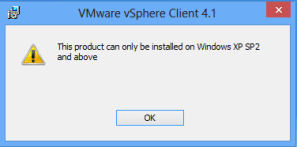Installing VMware vSphere Client 4.x on Windows 8
When installing VMWare vSphere Client 4.1 to manage VMWare ESX, you observe the following error:
“This product can only be installed on Windows XP SP2 and above.”
Although Windows 8 is obviously above XP SP2, it would seem that Windows 8 wasn’t about when vSphere Client 4.1 or 5.0 was released. In order to work around this you simply need to do the following:
1. Extract the content from the installation file to a folder of your choice. Using 7zip, you can right click the executable file, go to 7Zip, and choose Extract to folder name.
2. Go to the extracted folder, bin sub-folder, right click VMware-viclient.exe and choose Properties. Go to Compatibility tab, and check the option “Run this program in compatibility mode for” and pick Windows 7 from the list:
3. click OK to save the setting, and launch VMware-viclient.exe to start the installation again.
Note: If you are running vSphere 5.x you can download the newly released client which supports Windows 8 without the workaround above.
The link above also contains direct download links for all released vSphere clients.





